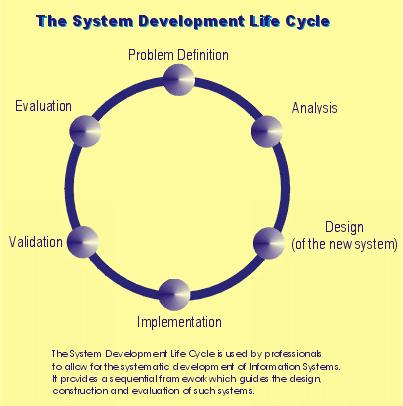Caribbean Secondary Education Certificate - Information Technology/Program Implementation
Contents
System Development Life Cycle
Systems Development Life Cycle (SDLC) is any logical process used by a systems analyst to develop an information system, including requirements, validation, training, and user ownership. An SDLC should result in a high quality system that meets or exceeds customer expectations, within time and cost estimates, works effectively and efficiently in the current and planned Information Technology infrastructure, and is cheap to maintain and cost-effective to enhance.
Computer systems have become more complex and usually (especially with the advent of Service-Oriented Architecture) link multiple traditional systems often supplied by different software vendors. To manage this, a number of system development life cycle (SDLC) models have been created: waterfall, fountain, spiral, build and fix, rapid prototyping, incremental, and synchronize and stabilize. Although in the academic sense, SDLC can be used to refer to various models, SDLC is typically used to refer to a waterfall methodology.
In project management a project has both a life cycle and a "systems development life cycle" during which a number of typical activities occur. The project life cycle (PLC) encompasses all the activities of the project, while the systems development life cycle (SDLC) is focused on accomplishing the product requirements.
History of SDLC
Systems development life cycle are the oldest formalized methodology for building information systems. The main idea was to pursue the development of information systems in a very deliberate, structured and methodical way, reiterating each stage of the life cycle. The traditional Systems development life cycle originated in the 1960s to develop large scale functional business systems in an age of large scale business conglomerates. Information systems activities resolved around heavy data processing and number crunching routines.
In the 1980s the Structured Systems Analysis and Design Method (SSADM) was based in SDLC. SSADM is a systems approach to the analysis and design of information systems, produced for the Office of Government Commerce, a UK government office concerned with the use of technology in government. Since the 1980s the traditional life cycle approaches to systems development has been increasingly replaced with alternative approaches and frameworks, which attempted to overcome some of the inherent deficiencies of the traditional SDLC.
Systems Development Phases
Systems Development Life Cycle (SDLC) adheres to important phases that are essential for developers, such as planning, analysis, design, and implementation, and are explained in the section below. There are several Systems Development Life Cycle Models in existence. The oldest model, that was originally regarded as "the Systems Development Life Cycle" is the waterfall model: a sequence of stages in which the output of each stage becomes the input for the next. These stages generally follow the same basic steps but many different waterfall methodologies give the steps different names and the number of steps seems to vary between 4 and 7. There is no definitively correct Systems Development Life Cycle model, but the steps can be characterized and divided in several steps.
Initiation/Planning
To generate a high-level view of the intended project and determine the goals of the project. The feasibility study is sometimes used to present the project to upper management in an attempt to gain funding. Projects are typically evaluated in three areas of feasibility: economical, operational, and technical. Furthermore, it is also used as a reference to keep the project on track and to evaluate the progress of the MIS team. The MIS is also a complement of those phase. This phase is also called the analysis phase.
Requirements Gatherings And Analysis
The goal of systems analysis is to determine where the problem is in attempt to fix the system. This step involves breaking down the system in different pieces and drawing diagrams to analyze the situation. Analysts project goals, breaking down functions that need to be created, and attempt to engage users so that definite requirements can be defined.
Design
In systems design functions and operations are described in detail, including screen layouts, business rules, process diagrams and other documentation. The output of this stage will describe the new system as a collection of modules or subsystems.
Build or Coding
Modular and subsystem programming code will be accomplished during this stage. This stage is intermingled with the next in that individual modules will need testing before integration to the main project. Planning in software life cycle involves setting goals, defining targets, establishing schedules, and estimating budgets for an entire software project.
Testing
The code is tested at various levels in software testing. Unit, system and user acceptance testing are often performed. This is a grey area as many different opinions exist as to what the stages of testing are and how much if any iteration occurs. Iteration is not generally part of the waterfall model, but usually some occurs at this stage.
Types of testing:
Data set testing Unit testing System testing Integration testing User acceptance testing Black box testing White box testing Module testing Regression testing Automation testing
Operations and Maintenance
The deployment of the system includes changes and enhancements before the decommissioning or sunset of the system. Maintaining the system is an important aspect of SDLC. As key personnel change positions in the organization, new changes will be implemented, which will require system updates.
Strength and Weaknesses of SDLC
Strengths
- Control
- Monitor Large projects
- Detailed steps
- Evaluate costs and completion targets
- Documentation
- Well defined user input
- Ease of maintenance
- Development and design standards
- Tolerates changes in MIS staffing
Weaknesses
- Increased development time
- Increased development cost
- Systems must be defined up front
- Rigidity
- Hard to estimate costs, project overruns
- User input is sometimes limited
References [1]

